April / May 2013
Cape Town
After my trip to the Philippines and a week in rainy and foggy Hong Kong, Cape Town greeted me with bright sunshine. The city lies at the foot of Table Mountain and is surrounded by two other peaks, Devil’s Peak and Lion’s Head. From all these peaks you have a breathtaking view of the city.
View from Table Mountain to Cape Town

View from Signal Hill to Cape Town (with ship Queen Elizabeth 2)
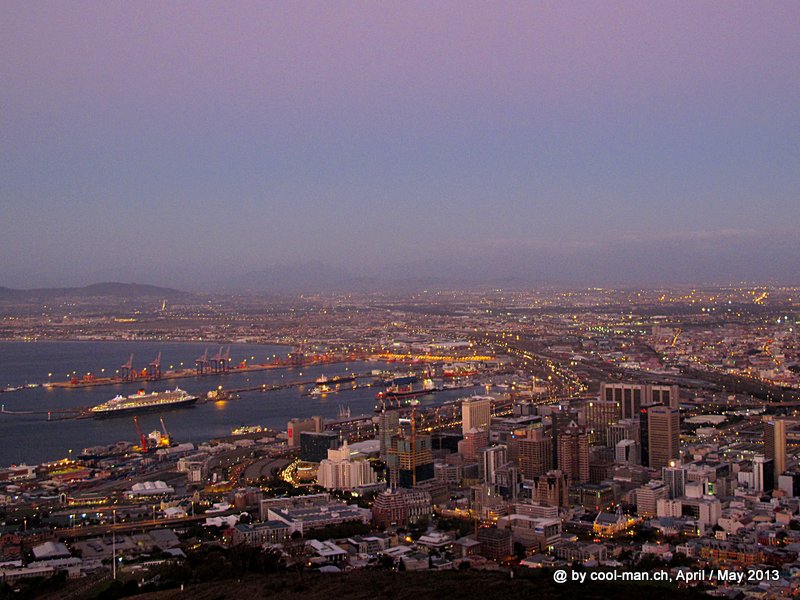
Sunset on Signal Hill

Living the good life in Cape Town

Already on the way from the airport to the hotel the taxi driver stressed that South Africa is a 1st world country and is not comparable with the rest of Africa. In fact, the infrastructure in South Africa is good and the hotels and restaurants are of European standard. But the prices are much lower than in Europe.
Before this trip South Africa was a dangerous country for me, where attacks and worse are the order of the day. I would like to point out right away that I was not attacked and that I consider South Africa relatively safe if you take the usual precautions in such countries. But carelessness is out of place because every day there are serious and even more less serious crimes. This is also a consequence of the fact that South Africa is one of the countries with the greatest inequality between the poor, who sometimes live under very difficult conditions in townships (former black settlements under the apartheid regime) and the rich in the secured villas in top locations.
Township near Cape Town

Many black people have inadequate qualifications and perform jobs with little added value such as guarding cars or swinging warning flags at construction sites. It is probably no coincidence that all my bed & breakfasts were owned by a white man, but breakfast was always prepared by a black employee. Many black South Africans are unemployed or work in the informal sector. On the other hand, many immigrants from other African countries are in South Africa. As I have been told, these immigrants are often more successful in the labor market because they are more industrious than the black South Africans. I was able to convince myself that many black people who worked in good restaurants and hotels were not from South Africa.
The difference between rich and poor is also due to the fact that the state offers many services poorly, such as education, health care or public safety. Also the use of the motorways is often not free of charge. People with little money have to make do with what the state provides free of charge, while the rich can afford better private care. After all, good black pupils from difficult backgrounds can nowadays make the leap into the middle class or even higher thanks to state subsidies.
South Africans are not really satisfied with their (black) government. Taxes are high, but it is often unclear whether the money is used for government services (isn’t that a polite way to describe corruption?) and whether it is used efficiently. In addition, the state often hires relatives and acquaintances of state employees instead of selecting the best candidate.
But now to my trip. I started in Cape Town, where I spent a week visiting the main attractions, exploring the surrounding area and organizing my further trip in South Africa. Cape Town was founded by Dutchman Jan van Riebeeck of the Vereenigde Oost-Indische Compagnie (VOC) in 1652. Here ships on their way to Asia were repaired and supplies increased. However, the cape is not a safe area. Heavy storms and reefs led to numerous ship losses. Countless shipwrecks lie around the cape on the seabed.
Today Cape Town is the second largest city in the country with 3.7 million inhabitants. In the city centre I didn’t feel quite safe during the day either, because at every turn you meet potentially shady characters. But nothing ever happened. At night, one should no longer be on foot, but also use a taxi for short distances.
The historic harbor facilities, called Victoria & Albert Wharf, were built over and are now a trendy and safe place with many restaurants and shops and the starting point for ship tours, among others to Robben Island.
Robben Island
A visit to this historic island is part of every Cape Town visit. Unwelcome people have always been deported there. Already the first prisoner was a political prisoner in the middle of the 17th century. Later, the Dutchmen detained a Muslim Indonesian prince there along with other prisoners. At times, lepers were deported to the island. During the apartheid regime, prisoners who rebelled against the regime were imprisoned alongside criminals. The most famous of these political prisoners was Nelson Mandela. He spent 18 years of his 27-year imprisonment on Robben Island.
Cell of Nelson Mandela on Robben Island, 2.5 m x 2.5 m

The Constantia wine region, very close to the city, was the first in South Africa. Some wineries like Constantia Beau produce such excellent wines that I bought a few bottles and took them with me on my journey – and in the evening after driving I had a sip of them.
The Constantia Beau Winery

First I drove with the rented car south of Cape Town along the sea. The places Mouille Point, Green Point, Sea Point, Clifton, Camps Bay and Hout’s Bay are very popular residential areas thanks to their sea view and sunset.
On the coast near Cape Town
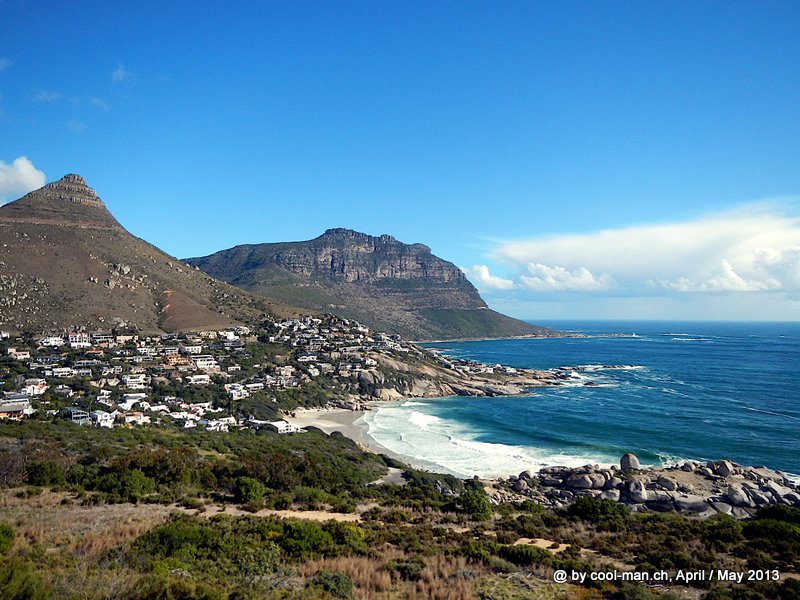

Hout Bay



From a road called Chapman’s Peak Drive there were breathtaking views of the crystal blue sea. Further I visited Cape Point (a headland south of Cape Town), Muizenberg (colored bathhouses) and Simon’s Town (big dwarf penguin colony).
Cape Point

Colored bath houses in Muizenberg
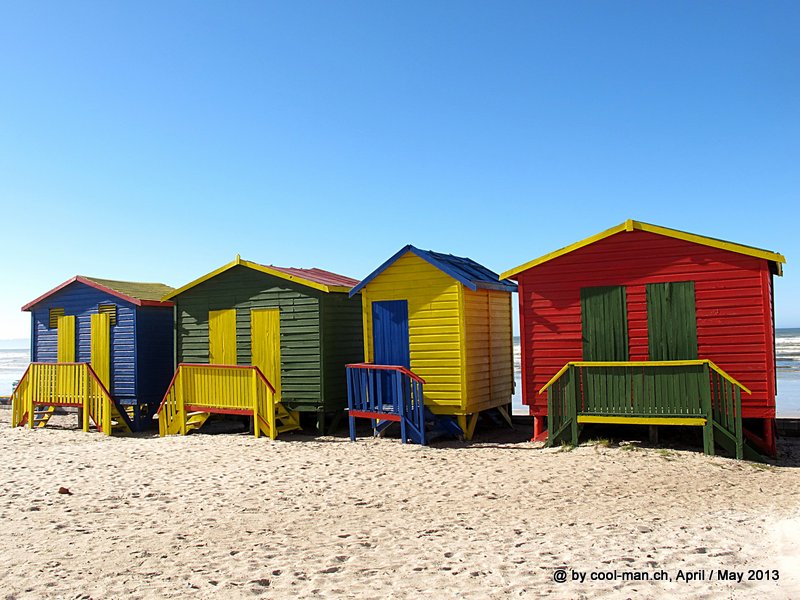
Pinguin in Simon’s Town

Stellenbosch
The next destination was the most famous South African wine region, Stellenbosch. The village of Stellenbosch is very well-kept and picturesque. This is also South Africa. In the afternoon I visited the three most beautiful wineries by car. The next day I was on a full day wine tour, so that I could taste the wine without driving a car. In the evening I had reserved a dinner at the best restaurant in Stellenbosch.
Houses in Stellenbosch

Oak barrels in a winery

A great dessert wine

The salon of my restaurant in a historic country house

The next day I drove for hours through lonely, desert-like regions to Oudtshoorn, in whose surroundings there are many ostrich farms. So it was clear which meat landed on my plate.
Kango Caves
The following day I visited the four kilometer long Kango caves. Findings show that people already lived in the entrance area of the cave in the Stone Age.
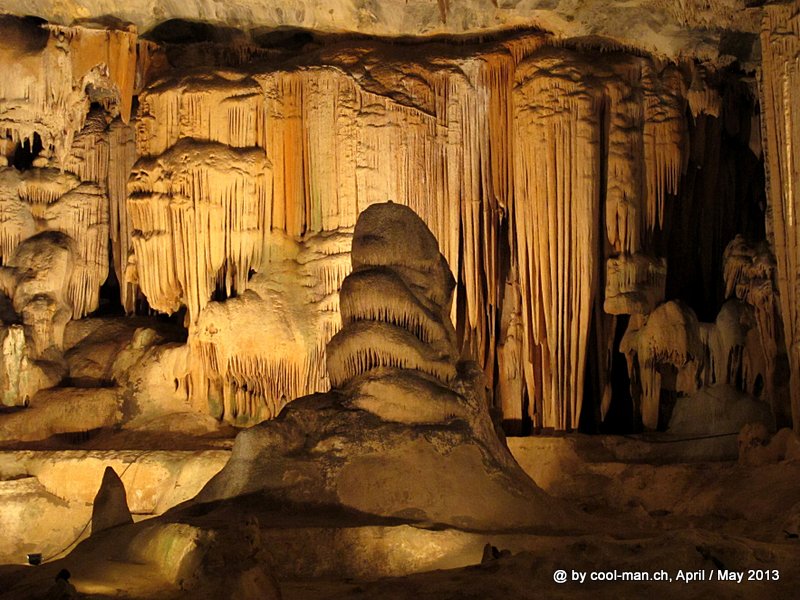
On a gravel road I drove over the Swartberg Pass and back to Oudtshoorn.
The Swartberg Pass

Next I visited the small town Knysna, which is located at a beautiful bay. Also here a so-called waterfront with shops and restaurants was built. In Knysna Mitchell, the most famous micro brewery in the Cape area, has its production site. Of course I visited it. I liked the Stout and the Milk and Honey Ale best.
The next day I went for a walk in the Nature’s Valley nature reserve. Not far away is the Bloukrans Bridge, where the world’s highest bungee jumping is offered (216 meters). Since it was raining, I decided not to jump. 😉 I spent the afternoon at the beach of Plettenberg, a tourist place with many chic boutiques and restaurants with a sea view.
Cape Agulhas, the southernmost point of Africa
The next day I drove through endless cornfields and pastures to the most southern point of Africa, Cape Agulhas. Not far from the Cape the cold Atlantic Ocean and the warm Pacific Ocean mix. This creates a unique ecosystem. The energy of the Cape cheered me up and so I decided to jog along the sea. The thunder of the waves mixed with the screeching of the birds and the cool, fresh air was slightly salty.
I spent the night in the southernmost Bed & Breakfast on the African continent. Immediately I was invited by the Dutch owner of this Design-B&B for a glass of white wine. The lighthouse was only about 150 meters away. It was a special feeling to see how the strong beam of light illuminated the room at night despite the heavy curtains at intervals of 5 seconds.
At Cape Agulhas, the southernmost point of Africa

Back in Cape Town, I lived in Mouille Point. During my first stay in Cape Town two weeks ago, I realized that this was the ideal place. On the one hand I was directly at the sea and had sea view, on the other hand it was only a ten minute walk to the Victoria & Albert Waterfront. And the area was safe, so you could also walk at night. Mouille Point was also a perfect starting point for jogging on the beach. On the right, one looked out to the sea and on the left, the Table Mountain rose.
The Two Ocean Acquarium is worth a visit


During the few remaining days in Cape Town I finally climbed Table Mountain after the weather was not ideal during my first stay. Before that I was warned not to underestimate such a hike and to be sufficiently equipped. It turned out that the hike did not cause any difficulties. The view from Table Mountain to Cape Town and the surrounding area was spectacular. Most people came up the mountain with the rotating cable car. It is the same cable car as the Titlis cable car in central Switzerland.
Johannesburg
I reached Johannesburg, the largest city in South Africa, with a comfortable long-distance bus. I decided to take the bus to get to know the landscape between the Cape and the plateau where Johannesburg is located. In Johannesburg I met a Swiss colleague who was on a business trip and then took a week off. He had an old friend in Johannesburg who accompanied us and could give us many good tips. This friend was an architect. I had the opportunity to accompany him at work and got to know great villas in beautiful neighborhoods. I noticed that the plots were additionally secured with electric fences next to the walls. For lunch we were on the terrace of one of Johannesburg’s best hotels with a view over the city. Johannesburg has a lot to offer in terms of quality of life. During the holiday week of my colleague we visited the Kruger National Park and the Blyde River National Park.
Kruger National Park
The Kruger National Park is about 550 kilometers from Johannesburg. We were able to cover a large part of it on motorways, so that we reached the Kruger Park in about seven hours. On an area of 23’400 km2 (360 km on 65 km) live countless animals, for example about 11’000 elephants, 5’000 giraffes, 2’000 lions and 2’700 rhinos. We spent four nights in the park, where we went in a private car on tar and gravel roads in search of game and spent the evenings in one of the 24 camps. Early in the morning and late in the evening one should be able to see the animals best. We therefore got up every morning at 5:30 am so that we could leave at six o’clock when the camps open their gates. Most of the time it was not worth getting up early. We rather saw the animals through the day. Since wild animals need a lot of space, it is not unusual to drive five to ten kilometers without seeing a big animal. The most common animals are Impalas, an antilobe species, of which 1.5 million live in Kruger Park. But elephants, giraffes, zebras and kudus were also seen relatively frequently. In almost every river you could see hippos and from time to time a sunbathing crocodile. We also saw buffaloes, hyenas and vultures. Also a rhino crossed our way. By the time the camera was ready, it had already disappeared into the bush. On the last morning we walked with two rangers into the bush. They explained to us that on more than 2,000 of these tours we only had to shoot an animal three times. In general, all animals are afraid of humans and disappear when we appear. Our tour was almost too uneventful. After all, our rangers found a herd of buffalo by following a bird that specialized in picking vermin from the buffalo skin. The rangers told us a lot of interesting things about the life and behavior of the animals and how they use this knowledge in their work.
A huge problem in South Africa is killing the rhinos because of their horn. Although China ratified the Convention on International Trade in Endangered Species of Wild Fauna and Flora (CITES) in 1993 and removed the rhinoceros horn from the catalogue of ingredients for Chinese medicine, there is still strong demand from China and Vietnam. The black market price in these countries for a horn made of keratin, the same material as our hair and fingernails, is several hundred thousand dollars. In 2012, 660 rhinos were poached in South Africa compared to a total population of about 20,000 animals. In the first four months of 2013 there were already 273, 201 of them alone in Kruger Park (with a total population of about 2’700 rhinos in Kruger Park). A sad new record is therefore expected to be reached in 2013. Again and again poachers are arrested or die in shootings with the rangers.
On this topic one hears many stories, the truth of which I cannot verify. At the border to Kruger Park in Mozambique, a new village with beautiful houses is said to have been built and the villagers are said to drive around in expensive cars. Apparently park guards are also involved in the poaching, because they know the locations of the rhinos best. And owners of private safari areas tolerate the poaching of their rhinos and receive part of the proceeds in return.
In certain areas, one therefore began to stun the rhinoceroses and to cut off the horn. As I have heard, even such rhinos are poached because a small stump of horn is left behind and it grows back again. Others color the horn so that it becomes unusable. I am not sure whether the poachers see at night whether a horn is colored.
Morning mood

Elephants



Zebras

Impalas

A big spider

Two waterbucks

Giraffes


Crocodile

A hyena
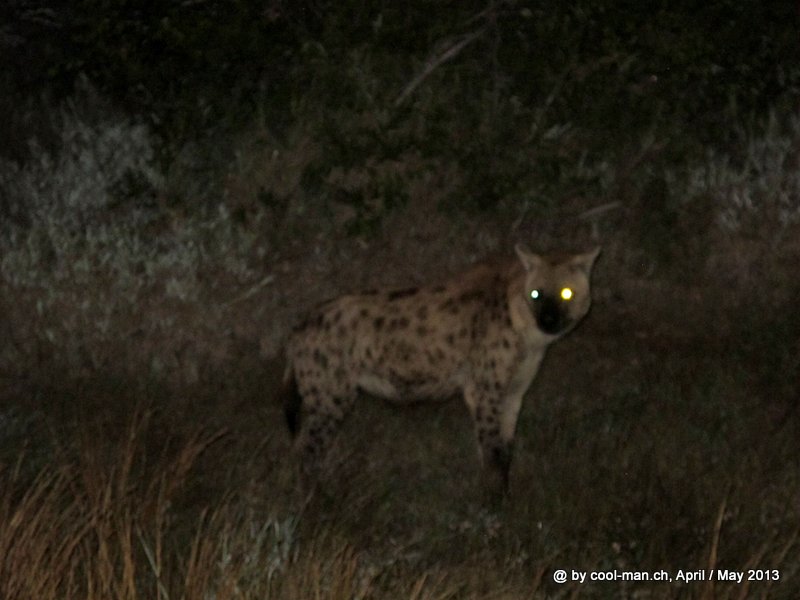
Blyde River National Park
The following two days we hiked and biked in the Blyde River National Park …

… and admired the Bridal Veil case near the town of Sabie.


Soweto
At the end of the trip we came to Soweto, where we visited Nelson Mandela’s house.
The house of Nelson Mandela

Then I traveled to the Seychelles.
This text is an automatic English translation from the German original by deepl.com